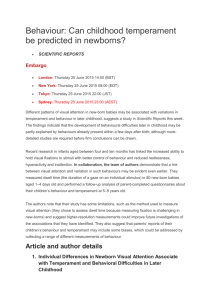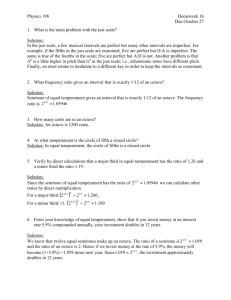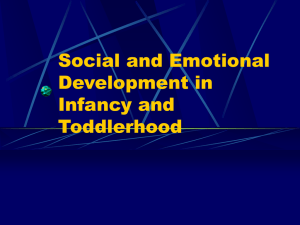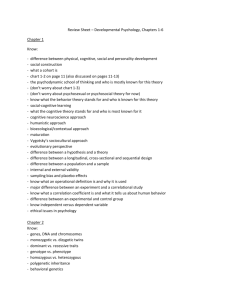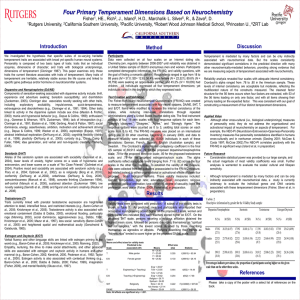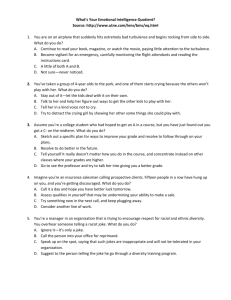Bipolar
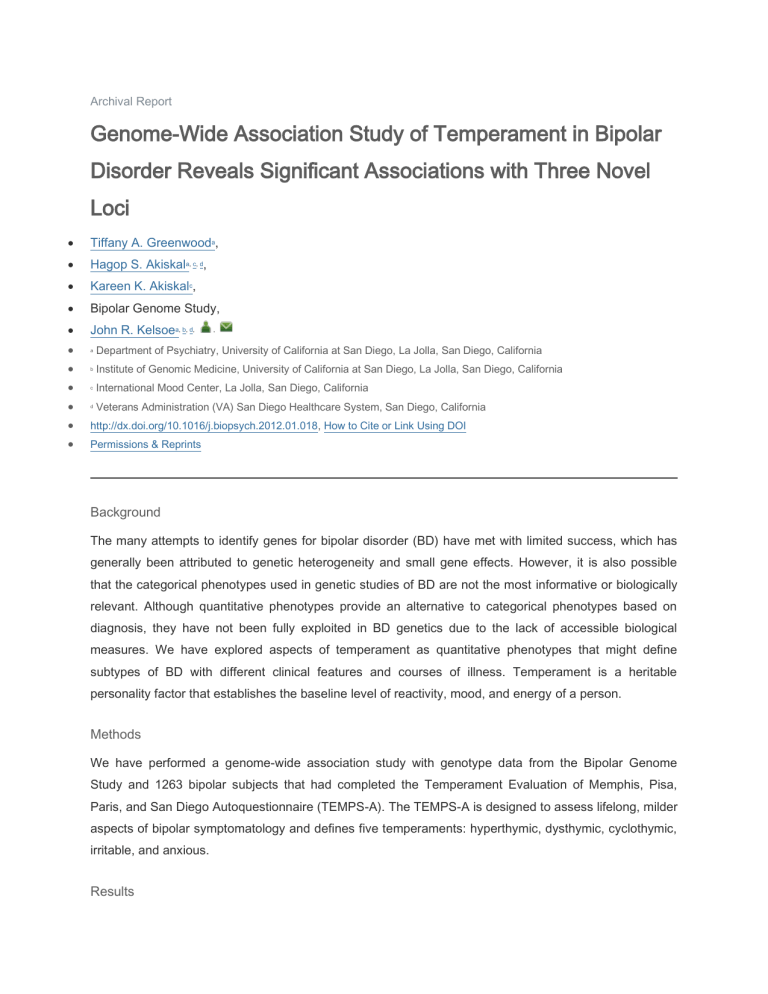
Archival Report
Genome-Wide Association Study of Temperament in Bipolar
Disorder Reveals Significant Associations with Three Novel
Loci
Tiffany A. Greenwood a
,
Hagop S. Akiskal a , c , d
,
Kareen K. Akiskal c
,
Bipolar Genome Study,
John R. Kelsoe a , b , d , ,
a
Department of Psychiatry, University of California at San Diego, La Jolla, San Diego, California
b
Institute of Genomic Medicine, University of California at San Diego, La Jolla, San Diego, California
c
International Mood Center, La Jolla, San Diego, California
d
Veterans Administration (VA) San Diego Healthcare System, San Diego, California
http://dx.doi.org/10.1016/j.biopsych.2012.01.018
, How to Cite or Link Using DOI
Permissions & Reprints
Background
The many attempts to identify genes for bipolar disorder (BD) have met with limited success, which has generally been attributed to genetic heterogeneity and small gene effects. However, it is also possible that the categorical phenotypes used in genetic studies of BD are not the most informative or biologically relevant. Although quantitative phenotypes provide an alternative to categorical phenotypes based on diagnosis, they have not been fully exploited in BD genetics due to the lack of accessible biological measures. We have explored aspects of temperament as quantitative phenotypes that might define subtypes of BD with different clinical features and courses of illness. Temperament is a heritable personality factor that establishes the baseline level of reactivity, mood, and energy of a person.
Methods
We have performed a genome-wide association study with genotype data from the Bipolar Genome
Study and 1263 bipolar subjects that had completed the Temperament Evaluation of Memphis, Pisa,
Paris, and San Diego Autoquestionnaire (TEMPS-A). The TEMPS-A is designed to assess lifelong, milder aspects of bipolar symptomatology and defines five temperaments: hyperthymic, dysthymic, cyclothymic, irritable, and anxious.
Results
The irritable temperament produced the most significant result with a genome-wide significant p value of
1.7 × 10
−8
on chromosome 1. The hyperthymic temperament produced additional genome-wide significant p values of 4.1 × 10
−8
and 2.1 × 10
−8
on chromosomes 12 and 22, respectively.
Conclusions
These results suggest that aspects of temperament might define subtypes of BD that are more clinically and genetically homogenous, which might aid in the identification of predisposing genetic variants.
Key Words
Bipolar disorder;
genetic;
genome-wide association;
temperament;
TEMPS-A
Difficulties in identifying genes for bipolar disorder (BD) have generally been attributed to such factors as genetic heterogeneity and small gene effects. However, it is also possible that the diagnostic systems
(DSM-IV and others) used in genetic studies of BD might not optimally define the illness for genetic mapping. Various mood-related traits and disorders with a range of severity are often observed in the families of BD probands ( [1] , [2] and [3] ), yet current categorical diagnostic systems are limited in their ability to adequately define this phenotypic variation. Some have suggested that BD and other mood disorders might be better conceptualized in a more quantitative manner as part of a continuous distribution of affective phenotypes ranging from very mild, subclinical affective traits to severe affective psychoses ( [3] , [4] , [5] and [6] ). This BD spectrum model would be consistent with that of a polygenic trait for which interactions between many genes of small effect produce a continuous variation in phenotype.
The use of a quantitative phenotype to model this variation and the associated biological mechanisms might be a powerful tool for identifying the genetic underpinnings of a polygenic trait like BD, yet few such quantitative phenotypes have been proposed for this purpose.
Temperament has been defined as a heritable personality factor that remains stable over time and establishes the baseline level of reactivity, mood, and energy of a person ( 7 ). Although normal variations in temperament exist within the population, it has been suggested that a dysregulation of temperament is the fundamental abnormality that predisposes to the development of bipolar spectrum disorders, with more extreme variations in temperament conferring greater risk ( [4] , [8] , [9] and [10] ). In this model, affective temperament is influenced by numerous genes of small effect, resulting in a continuous distribution of mood regulation and reactivity. More extreme manifestations of affective temperament might in turn predispose individuals to episodes of mania and depression. Such a model is consistent with the observation of milder forms of the bipolar phenotype in family members of probands with BD and with
a polygenic mode of transmission. By focusing on the underlying affective dysregulation, temperament might be a phenotype that is more sensitive and closer to the underlying biological abnormalities.
Several studies have demonstrated the ability of temperament measures to predict risk for bipolar spectrum disorders ( [4] , [11] , [12] , [13] and [14] ) and to discriminate between affected subjects, normal control subjects, and healthy relatives of affected subjects ( [15] , [16] , [17] and [18] ). Although mixed results have been observed for the hyperthymic temperament, with BD subjects scoring highest on this scale in some studies ( [17] and [19] ) and control subjects scoring highest in others ( [15] , [16] and [18] ), data suggest that this temperament might be most relevant to the bipolar I (BDI) subtype. The hyperthymic temperament has also demonstrated the ability to distinguish control subjects from unaffected relatives, indicating an ability to detect latent genetic vulnerability ( [15] and [18] ). In a prospective study on the offspring and siblings of BD patients, hyperthymic and dysthymic temperaments were present before a superimposed mood episode developed ( 14 ), further suggesting that the hyperthymic temperament might be particularly associated with a genetic vulnerability for BD.
Temperament can be assessed along several dimensions that define qualitatively different aspects of affective regulation. Different sets of genes might be associated with each of these dimensions of temperament, which would suggest that the different affective temperaments might define subtypes of BD with different clinical features and courses of illness. Several studies provide support for this idea. For example, studies of temperament suggest that some forms of major depression with hyperthymic temperament might be more related to BD ( [9] and [20] ). Different temperaments within BD have also been associated with different rates of relapse and response to antidepressants ( [20] and [21] ). Finally, different temperaments in BD have been shown to be associated with different clinical courses
( [22] and [23] ).
We have explored the use of temperament, as assessed by the Temperament Evaluation of Memphis,
Pisa, Paris, and San Diego Autoquestionnaire (TEMPS-A), as a quantitative phenotype for BD that might define more homogenous subgroups of patients when assessed within a BD sample. The TEMPS-A is a self-report questionnaire designed to quantify temperament and assess lifelong, milder aspects of bipolar symptomatology ( [24] and [25] ). The five temperaments defined by this scale (hyperthymic, dysthymic, cyclothymic, irritable, and anxious) have been implicated in various affective disorders, and several have shown evidence of heritability and familiality in BD ( [4] , [11] , [12] , [13] , [15] , [18] and [26] ). The reliability and internal consistency of the TEMPS-A is well-documented, and the temperaments have demonstrated stability over time, with one study reporting stability up to 6 years ( [23] , [27] , [28] , [29] and [30] ). We report the results of our genome-wide association (GWA) analyses of these temperaments in 1263 unrelated BDI subjects and the identification of several genes that might predispose to BD through their modulation of temperament as well as define subgroups of BD patients with similar clinical features and courses of illness.
Methods and Materials
Subject Ascertainment
For genotyping as part of the Bipolar Genome Study (BiGS), a total of 1566 unrelated BDI subjects of
European Ancestry were selected from those collected as part of Wave 5 by the National Institute of
Mental Health Genetics Initiative for Bipolar Disorder at 11 sites across the US. All subjects provided written informed consent according to the local institutional review boards and were interviewed with the
Diagnostic Interview for Genetic Studies (DIGS [ 31 ]). Information was also obtained from family informants and medical records and reviewed along with the interview by a panel of experienced clinicians to obtain a final best-estimate diagnosis.
Control subjects were selected from those ascertained through a National Institute of Mental Healthsupported contract mechanism between Dr. Pablo Gejman and Knowledge Networks. All subjects donated a blood sample and were given a medical questionnaire. The selected control subjects were matched for gender and ethnicity with the BD cases, and all subjects who endorsed a history of BD, psychosis, or major depression were excluded. A total of 1434 control subjects of European Ancestry were available for analysis.
Genotyping and Cleaning
All subjects were genotyped in two sample sets for the Affymetrix SNP Array 6.0 (Affymetrix, Santa Clara,
California). The initial sample of 321 Wave 5 subjects was genotyped at the Broad Institute as part of the
Genetic Association Information Network (GAIN) and published previously as part of study of BD involving a larger sample of 1001 BDI cases and 1033 control subjects ( 32 ). Subsequent genotyping of the remaining 942 Wave 5 subjects was performed at the Translational Genomics Institute (TGEN) as part of a larger sample of 1190 BDI cases and 401 control subjects. An extensive quality control process
(described elsewhere in detail) ( 32 ) was performed on each sample separately to eliminate individuals with >10% missing data and single nucleotide polymorphisms (SNPs) with poor allele clustering, >10% missing data, duplicate errors, minor allele frequencies (MAFs) <.01, and Hardy-Weinberg
Equilibrium p values <10
−6
. An additional round of quality control performed on the merged GAIN and
TGEN samples resulted in 703,012 passing SNPs.
Phenotypes
The TEMPS-A was administered to 1263 of the 1566 Wave 5 BDI subjects that were genotyped as part of the BiGS sample. Although each of the 1263 subjects had complete data for at least one of the subscales, an average of 1176 subjects (range 1172–1185) were available for the analysis of each temperament on the basis of complete subscale data due to the presence of missing data for individual
questions. The TEMPS-A includes a total of 109 self-rated true/false questions (110 for women) designed to assess hyperthymic, dysthymic, cyclothymic, irritable, and anxious temperaments with 21 questions specific to each temperament subscale and 26 for the anxious subscale ( [24] and [25] ). The TEMPS-A has been shown to have very good reliability and internal consistency, with the temperaments showing good stability over time ( [27] , [28] , [29] and [30] ).
Statistical Analyses
Quantitative trait analyses were performed for these temperaments with linear regression in PLINK ( 33 ).
The trait distribution for each temperament was approximately normal in this sample. Three covariates were incorporated into the model as determined appropriate via correlation analyses: gender, Global
Assessment of Functioning score, and age at onset (AAO) of BD. Genomic inflation factors for the analysis of each subscale ranged from 1.00 to 1.01, so no correction for population stratification was deemed necessary. This is consistent with the negligible population structure that has generally been observed in the complete GAIN and TGEN samples, as described elsewhere ( 32 ). For comparison purposes, analysis of BD in the 1566 Wave 5 subjects and combined 1434 GAIN and TGEN control subjects was performed with logistic regression in PLINK.
Results
The average scores (± SDs) across the temperament subscales were as follows: 9.1 (± 4.4) for hyperthymic, 10.8 (± 4.1) for dysthymic, 12.7 (± 5.5) for cyclothymic, 7.6 (± 4.8) for irritable, and 13.0 (±
6.4) for anxious. As might be expected, significant correlations were observed between four of the five temperaments, as shown in Table 1 . Relatively high correlations ( r = .44–.68, p < .001) were observed between the dysthymic, cyclothymic, irritable, and anxious temperaments. Weaker correlations were observed for the hyperthymic temperament with the dysthymic (negative), cyclothymic, and irritable temperaments ( r = .14–.24).
Table 1. Correlations Among the Five TEMPS-A Subscales and with Relevant Covariates
Gender GAF AAO Hyperthymic Dysthymic Cyclothymic Irritable
Hyperthymic ns
Dysthymic .10
Cyclothymic ns
Irritable
Anxious ns
.16
a ns ns
−.25
a
−.14
a
−.24
a
−.25
a
−.31
a .14
a
−.20
a
−.27
a .19
a
−.25
a
−.21
a ns
.53
a
.44
a
.61
a
.68
a
.66
a .59
a
All correlation coefficients listed are significant with p < .01.AAO, age at onset of bipolar disorder, which refers to the age at onset of either the first manic or depressive episode; GAF, Global Assessment of Functioning, which reflects the current state and level of impairment of the subject at the time of scale administration; ns, nonsignificant; TEMPS-A, Temperament Evaluation of Memphis, Pisa, Paris, and San Diego Autoquestionnaire. a p < .001.
Table options
Because the TEMPS-A is a self-report questionnaire, we investigated several factors that might have an impact as potential covariates on the response of a subject: namely, gender, current state, and illness severity. The sample was approximately 64% female, and weak yet significant correlations with gender were observed for the dysthymic and anxious temperaments only, as shown in Table 1 . Because subjects might have been euthymic, depressed, or manic at the time of testing, we assessed the impact of the current state and level of impairment of a subject at the time of testing via the Global Assessment of
Functioning (GAF) score, which had a mean of 64.3 (± 14.7) in our sample and revealed moderately negative correlations ( r = − .20 to −.25, p < .001) with all temperaments except hyperthymic. Finally, we evaluated AAO of BD, defined as the AAO of the first manic or depressive episode, as a proxy for illness severity, because an earlier AAO typically reflects a more severe form of illness. In this sample, earlier
AAO was significantly correlated with an increase in the number of episodes and the frequency of mixed symptoms, suicidal ideation, rapid cycling, and comorbidity ( p < .001). The AAO had a mean of 18.5 (±
9.7) years in this sample and was found to have moderately negative correlations ( r = −.14 to −.31, p <
.001) with all temperaments except hyperthymic. These three factors seem to be important covariates for all but the hyperthymic temperament and were therefore included in the analyses of the significantly correlated temperaments.
We also assessed the five temperaments with regard to several clinical characteristics, as detailed in Table S1 in Supplement 1. The dysthymic, cyclothymic, irritable, and anxious temperaments revealed a consistent pattern of moderate positive correlations ( r = .14–.39, p < .001) with suicidal ideation, rapid cycling, and comorbid anxiety spectrum disorders. The cyclothymic, irritable, and anxious temperaments additionally revealed significantly more manic and depressive episodes/year of illness and more mixed symptoms in both mania and depression ( p < .001). The hyperthymic temperament, by contrast, revealed only a weak negative correlation with social phobia ( r = − .12, p < .001) and no significant correlations with any other clinical factor. These results further suggest that the hyperthymic temperament might represent an independent subtype of BD with a different course of illness.
The GWA results of the five temperaments are displayed in Figure 1 . Genomic regions of interest were defined as those with at least two SNPs with p < 10
−4
and adequate support for association from surrounding SNPs with at least two additional SNPs with p < 10
−3
, all within 100 kilobase pairs. Several such regions were identified across the five temperaments, and the regions meeting these criteria that were located within or near genes are indicated. The SNPs with p < 10
−4
within regions reaching GW significance are detailed in Table 2 , and a complete listing of all SNPs with p < 10
−4
is provided in Table
S2 in Supplement 1, with the results of the case-control analysis provided as a comparison with the results for the relevant temperament.
Figure 1. Genome-wide association results for all five temperaments. The physical position is shown along the x axis, color-coded by chromosome, and the –log ( p value) for each single nucleotide polymorphism (SNP) is shown along the y axis, as generated by Haploview 4.0 (Broad Institute, Cambridge, Massachusetts). Horizontal lines indicate the p < 10
−4 and p < 5 × 10
−8
thresholds. All genic regions containing at least two SNPs with p < 10
−4
and support for association from neighboring SNPs are indicated and detailed in Table 2 . Genic regions with at least one SNP meeting the genome-wide significance criteria of p < 5 × 10
−8
are highlighted in blue.
Figure options
Table 2. Summary of all SNPs with p Values < 10
−4
within Regions Reaching GW Significance
Gene(s) rs ID Chr Position A1/A2 MAF
β p
BD vs. CTL
OR p
Gene(s)
Hyperthymic
MDM1 (12q15)
Mdm1 Nuclear Protein
Homolog (mouse)
FBLN1 (22q13.31)
Fibulin 1
Irritable
INTS7 (1q32.3) rs ID rs4913441 12 67058505 T/C rs416350 rs382518 rs390978 rs743931
Chr
12
12
12
22 rs2358385 1
Position
67065680
67066354
67074588
44338204
210197057
A1/A2 MAF
β
A/G
C/T
T/A
G/A rs1985671 22 44340568 G/T rs2051616 22 44342187 G/A rs739215 22 44346190 G/A
T/C
.11
.06
.11
.10
.29
.37
.43
.37
.02 p
BD vs. CTL
OR p
1.44 1.3E-06 1.02 .809
2.10 4.1E-08 a 1.17 .172
1.41 2.7E-06 .99 .872
1.38 5.5E-06 .97 .758
−1.09 1.2E-07 .96 .455
−1.06 2.1E-08 a .98 .751
−.98
8.3E-08 1.00 .924
−1.04 4.3E-08 a .99 .781
4.08 1.4E-07 .86 .455
Integrator Complex Subunit 7 rs41502452 1 rs17018310 1 rs17018311 1
210215035 T/G
210220866 T/C
210221631 C/T
.02
.02
.02
4.01 3.4E-07 .87 .462
4.08 1.4E-07 .87 .457
4.21 1.7E-08 a .91 .632
DTL (1q32.3)
Denticle-Less Homolog rs17018375 1 rs17018399 1
210276230 G/A
210284213 A/G
.02
.02
4.08 1.4E-07 .88 .518
3.98 2.7E-07 .88 .524 rs17018426 1 210308853 G/C .02 4.17 4.8E-08 a .86 .446
BD, bipolar disorder; Chr, chromosome; CTL, control subject; MAF, minor allele frequencies; OR, odds ratio; SNP, single nucleotide polymorphism. a
Genome-wide (GW) significant p values (< 5 × 10
−8
).
Table options
Three SNPs on chromosomes 12 and 22 were found to be GW significant ( p < 5 × 10
−8
) in the analysis of the hyperthymic temperament as shown in Figure 1 . These SNPs are located within or near the MDM1 and FBLN1 (isoform D) genes, respectively, and several other nearby SNPs provide additional support for the association, as detailed in Figures 2 A and 2 B. These SNPs were not significant in our case-control analysis of BD in the Wave 5 subjects or in the analyses of the other four temperaments
( Table 2 ). MDM1 encodes a nuclear protein similar to the mouse double minute 1 protein. The fibulin 1 gene ( FBLN1 ) encodes a secreted glycoprotein that might be important for certain developmental processes and contribute to the organization of the extracellular matrix ( 34 ). FBLN1 might also play a significant role in modulating the neurotrophic activities of amyloid precursor protein ( 35 ). Four splice variants, A–D, differing in the 3' end have been identified for FBLN1 ( 36 ). Although each variant encodes a different isoform, no functional distinctions have been identified among the four variants. Several other genes of possible interest were identified, although the SNPs did not meet GW significance.
Figure 2. Details of the genome-wide significant associated regions for the hyperthymic temperament on chromosomes 12 (A) and 22 (B) and for the irritable temperament on chromosome 1 (C). Physical position and gene annotations according to HapMap release 22 are shown along the x axis, and −log ( p value) is shown on the left y axis. Recombination rate within the European (CEU) samples is shown on the right y axis in blue. The most significant single nucleotide polymorphism (SNP) for each region is indicated as a large red diamond, and all other
SNPs are colored according to linkage disequilibrium levels ( r
2
) with the primary SNP, as calculated from HapMap
Release 22 CEU population data, with darker red representing higher values. Reference Sequence (RefSeq) genes are shown with all possible exons and arrows indicating transcript direction.
Figure options
Analysis of the irritable temperament also produced two SNPs of GW significance ( p < 5 × 10
−8
), as shown in Figure 1 . These SNPs lie within the neighboring INTS7 and DTL genes on chromosome 1, with several nearby SNPs providing additional support for the association with this region, as detailed in Figure 2 C. INTS7 encodes a subunit of the Integrator complex that mediates 3' end processing of small nuclear RNAs U1 and U2 ( 37 ). DTL encodes a denticle-less homolog that might be necessary for the regulation of DNA replication. Again, these SNPs were not significant in the case-control analysis of BD in the Wave 5 subjects ( Table 2 ) or in the analyses of the other four temperaments. Again, several other genes of possible interest were identified, although the SNPs did not meet GW significance.
Although the analyses of the dysthymic, cyclothymic, and anxious temperaments did not produce GW significant results, several genes of potential interest were identified as shown in Figure 1 . Interestingly, the hyperthymic, dysthymic, and cyclothymic temperaments revealed associations with the same gene, LRRC4C , but with different regions within and around the gene, as detailed in Figure
3 .
LRRC4C (formerly NGL1 ) encodes for a leucine-rich repeat protein that functions as a specific binding partner for Netrin-G1 ( NTNG1 ), which is a member of the netrin family of axon guidance molecules ( 38 ).
No other genes were present in this region.
Figure 3. Details of the LRRC4C gene region on chromosome 11p12 and the association results for the hyperthymic, dysthymic, and cyclothymic temperaments. Physical position and gene annotations according to
HapMap release 22 are shown along the x axis. The −log ( p value) is shown on the y axis for each temperament with the hyperthymic results in red, the dysthymic results in blue, and the cyclothymic results in green. The pattern of linkage disequilibrium across the region is presented as determined from the HapMap Release 22 European
(CEU) population data. Reference Sequence (RefSeq) genes are shown with all possible exons and arrows indicating transcript direction.
Figure options
Discussion
Because bipolar patients display significant clinical variability, which might reflect underlying genetic heterogeneity, the use of the DSM-IV diagnosis of BD as a phenotype might not have the best power to detect causal genes. We have explored the use of temperament to define subtypes of BD and create more homogenous groups of patients with more similar clinical courses. These subgroups of patients might also show less genetic heterogeneity, which might facilitate the detection of the underlying genetic variants.
The average temperament scores and the correlation structure between the TEMPS-A subscales observed in our sample is consistent with previous reports in other samples of healthy control subjects and/or subjects with BD and major depressive disorder ( [23] , [39] and [40] ). The cyclothymic and irritable temperaments showed the highest degree of correlation ( r = .68) in our data, and there has been some debate whether irritable is its own temperament or a subtype of the cyclothymic temperament
( [27] and [41] ). The high degree of correlation ( r = .61) between the dysthymic and anxious temperaments in our sample is also consistent with the observation of overlap between these temperaments, largely in terms of cognitive attributes ( 42 ).
The hyperthymic temperament seems to be independent of the other temperaments, as evidenced by the low degree or absence of correlations with them. This is consistent with a previous study that found the hyperthymic and dysthymic temperaments to have nearly complete opposite loadings in a factor analysis of affective temperaments ( 27 ). Furthermore, a recent study has suggested that there are effectively two temperaments in BD subjects, with the dysthymic, cyclothymic, irritable, and anxious temperaments combining to form a “cyclothymic-sensitive” subtype characterized by rapid fluctuations of mood and emotional stability that presents more often with comorbid anxiety disorders than the hyperthymic temperament ( 23 ). This fits well with our data, which show a similar pattern of correlations with comorbid anxiety disorders as well as rapid cycling and suicidal ideation, for these four temperaments and not the hyperthymic temperament. However, we found little correlation with any clinical features for hyperthymic, in contrast to the previously reported association of the hyperthymic temperament with a greater number of hospital stays and more manic episodes.
Our association analyses of the temperaments produced a total of five p values meeting GW significant criteria. The hyperthymic temperament, generally characterized by exuberant, upbeat, over-energetic, and overconfident lifelong traits, produced three GW significant results on chromosomes 12 and 22 in the double minute 1 ( MDM1 ) and fibulin 1 ( FBLN1 ) genes, respectively. The irritable temperament also produced two GW significant results on chromosome 1 in an integrator subunit gene ( INTS7 ) and the denticle-less homolog gene ( DTL ). These neighboring genes both showed positive correlations with this temperament, which is characterized by a highly unstable mixture of dysthymic and hyperthymic traits and manifests itself in such behaviors as habitual complaining, overcritical attitudes, and angry outbursts ( 41 ).
Other temperaments also indicated several regions of interest that were not GW significant, such as the common finding of association ( p < 10
−4
) with the LRRC4C gene region for the hyperthymic, dysthymic, and cyclothymic temperaments, with the hyperthymic temperament giving an effect in the opposite direction. These three temperaments have been shown to predict risk for bipolar spectrum disorders, with the hyperthymic temperament being of specific relevance to BDI. This might explain the superior performance of this temperament in our sample of BDI subjects. The dysthymic temperament is characterized by low energy, low spirits, and negative cognitions and might thus be more relevant to major depressive disorder than BDI. The cyclothymic temperament is characterized by rapid and unpredictable mood swings between the depressive and the hyperthymic poles and has been conceptualized as a subthreshold expression of bipolarity that might be of particular relevance to the bipolar disorder II (BDII) subtype on the basis of clinical and prospective data showing high sensitivity and specificity of cyclothymic lability for BDII ( [9] and [43] ). Interestingly, one study reported high heritability estimates for the hyperthymic (50.9%, p < .001) and irritable (74.8%, p < .001) temperaments in 31 extended Caucasian families with BD, whereas the dysthymic temperament was moderately heritable
(29.2%, p < .05), and the cyclothymic temperament was not significantly heritable ( 26 ). It might thus be that the hyperthymic and irritable temperaments provide more power for gene identification within the context of BD.
Because the cyclothymic temperament might be of more relevance to BDII, we should not expect this temperament to perform as well in our sample of BDI subjects. Interestingly, however, the best association for the cyclothymic temperament was observed for the SLTRIK1 gene region on chromosome
13q31 with several p values < 10
−5
. The 13q31 region has been implicated previously in a linkage study of
BD families segregating psychotic symptoms ( 44 ), and linkage to the nearby 13q32 region has been observed for BD ( [45] , [46] and [47] ). Associations with SLITRK1 , which functions in neurodevelopment, have also been reported for Tourette's Syndrome ( 48 ).
Several GWA studies of personality and temperament have been published assessing Neuroticism
( [49] , [50] and [51] ), five personality traits from the NEO Personality Inventory ( 52 ), and four temperaments from Cloninger's Tridimensional Personality Questionnaire ( 53 ). Despite the large samples employed in these studies, no GW significant associations were observed, and few associations had p values < 10
−6
. Several genes of potential interest were identified, including associations between MAMDC1 and PDE4D and Neuroticism ( [49] and [50] ). None of the top SNPs or genes in our study of the TEMPS-A corresponded with the top SNPs in these studies, nor were any of the top SNPs in those studies even nominally significant ( p < .05) in our data. All of these earlier GWA studies of personality and temperament were performed with population-based samples. Unlike the NEO
Personality Inventory and Cloninger's Tridimensional Personality Questionnaire, which were developed to assess aspects of personality in the general population, the TEMPS-A was specifically designed to quantify temperament in the context of bipolar symptomatology ( [24] and [25] ). It is thus possible that the
sole use of BDI cases in our analyses provided increased power for the detection of genes associated with variation in temperament compared with other studies.
Previous GWA studies of BD have implicated several potential susceptibility genes, with ANK3 on chromosome 10q21.2 and CACNA1C on chromosome 12p13.3 featuring prominently in a large collaborative GWA meta-analysis study ( 54 ). In this study, p values of 1.3 × 10
−8
and 7.0 × 10
−8
were observed for rs1938526 in ANK3 and rs1006737 in CACNA1C , respectively, in a sample of 4387 cases and 6209 control subjects. A comparison of these results with the current sample fails to find support for association for these two SNPs with any of the five temperaments ( p > .05). Each temperament did produce associations elsewhere in these two genes with p values in the range of .05–.0005 for many
SNPs within ANK3 and CACNA1C . However, given the distance of these SNPs from those originally reported, these associations do not constitute a replication of association with these genes.
A potential limitation of this study might be the sole use of BDI subjects, because TEMPS-A data for control subjects were not available. However, this has enabled us to examine the genetic determinants of temperament within the context of BD. Another potential limitation is that some subjects might have been manic or depressed at the time of assessment, whereas others were euthymic. Although the TEMPS-A is designed to assess temperament as a lifelong characteristic with the subscales demonstrating good stability over time ( [29] and [30] ), it is possible that the self-assessment of the subject might be influenced by state at the time of testing. In the absence of quantitative manic or depressive symptom ratings, we used the GAF score as a covariate in the association analyses to control for state at the time of testing. To assess the possible effect of state and the effectiveness of the GAF score as a covariate, we compared subjects who met criteria for current mania or depression with those that were euthymic on the basis of the DIGS interview ( Figures S1 and Table S3 in Supplement 1). Euthymic subjects comprised
79% of the sample and revealed significant differences in GAF scores and all TEMPS-A subscales, except hyperthymic, when compared with depressed subjects. No other group comparisons were significant, suggesting that state effects are relatively minor in this sample. We have also covaried for
AAO as a proxy for illness severity, because subjects with a more severe course of illness might respond differently than subjects with a milder course, regardless of whether they are currently symptomatic.
Although AAO might be difficult to determine historically, we observed correlations with a number of measures of illness severity, thereby supporting the accuracy of the measurement and its validity as a proxy for illness severity. Finally, when GAF and AAO are included in the previously described analysis, no group differences remain significant, suggesting that the combination of GAF and AAO provides a reasonable correction for any state-related differences in TEMPS-A subscales.
With the analysis of five temperaments, the issue of multiple comparisons must be considered. However, as shown in our data and those of others, four of the five temperaments are highly correlated ( r = .44–.68) and share a pattern of correlations with several clinical characteristics, indicating that these analyses are not entirely independent and complicating corrections for multiple comparisons ( 23 ). If we consider that the hyperthymic temperament seems to be relatively independent of the other four temperaments and
correct for the analysis of two effectively independent temperament groups, two of our findings remain
GW significant: hyperthymic with the FBLN1 gene and irritable with the INTS7 gene. These results will ultimately need to be validated in an independent sample.
If extreme variations in temperament predispose to greater risk of developing BD, affective temperaments might represent the most prevalent phenotypic expression of the genes underlying BD ( 55 ), with the genes being maintained in the population because they have favorable evolutionary properties and BD representing an aberration of the expression of these genes ( [3] and [6] ). The use of temperament measures to create more clinically and genetically homogenous subgroups of patients might aid in the identification of genes underlying BD susceptibility. The results of our analyses suggest that at least some measures of temperament might have utility in genetic studies of BD.
